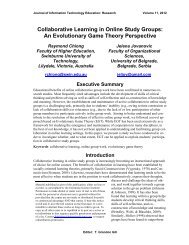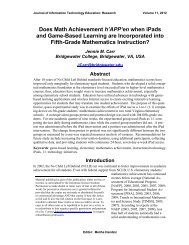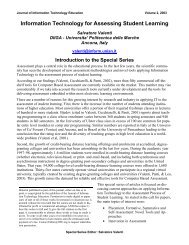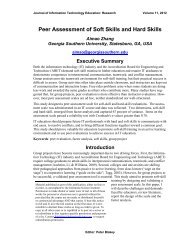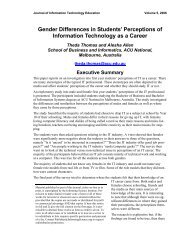Put Title Here Using Heading 1 Style - Journal of Information ...
Put Title Here Using Heading 1 Style - Journal of Information ...
Put Title Here Using Heading 1 Style - Journal of Information ...
Create successful ePaper yourself
Turn your PDF publications into a flip-book with our unique Google optimized e-Paper software.
Thomas, Davis, & Kazlauskas<br />
There is no doubt that doing exercises like this give the students valuable practice and help them<br />
to develop their SQL skills. But how can students’ critical thinking skills and SQL be synergistically<br />
enhanced? Figure 3 gives an example <strong>of</strong> how this might be achieved.<br />
In an introductory SQL subject, we could use the following approach to scaffolding the students thinking to<br />
help them to learn the SQL. This also uses students’ systems thinking skills and makes connections between<br />
the knowledge they have acquired in different areas:<br />
i. Product 1234 has been recalled due to a fault. We need to contact all the customers who have<br />
bought this product in the past six months.<br />
a. What information do we need to get about the customers?<br />
b. Where is the information stored about the customers and where is the information stored on<br />
who has bought which products? List the tables and then determine how these tables are<br />
linked through their foreign keys.<br />
c. Write one SQL statement that will extract the information needed into a list form.<br />
ii. Order 4444 has been cancelled and needs to be deleted from the database.<br />
a. Delete order 4444 from the ORDER table.<br />
b. You should have an error message – what is the error message and why did it occur? (Foreign<br />
key problem with the ORDERLINE table. Bracket not part <strong>of</strong> the question – merely for<br />
clarification)<br />
c. Write the SQL statements to delete order 4444 entirely without getting the error.<br />
d. If we delete an order and its order lines, are there any other parts <strong>of</strong> the database that might<br />
need to be updated to keep the database in sync? (This might refer to updating <strong>of</strong> accounts or<br />
stock levels – depends on the database structure.)<br />
Figure 3: An SQL example<br />
The questions in Figure 3 help the students to scaffold their thinking and to work out how to handle<br />
problems. In these examples the knowledge <strong>of</strong> how foreign keys work has been integrated<br />
into the problem. The students need to read and understand error messages instead <strong>of</strong> asking a<br />
tutor to help them solve any difficulties they experience as a first response. By including problem<br />
solving <strong>of</strong> the foreign key issue within the solution <strong>of</strong> the SQL problem, the students apply their<br />
new knowledge as well as practising and extending their ability to think critically by evaluating<br />
their own work. The questions help the students to work at the higher-levels <strong>of</strong> Bloom’s taxonomy,<br />
namely, analysis, evaluation, and creation. Students are also required to think <strong>of</strong> how different<br />
parts <strong>of</strong> a system might affect one another and apply this in the last part <strong>of</strong> the question.<br />
As students’ abilities to think critically improve, they have a reduced need for the scaffolding and<br />
therefore the questions lecturers ask <strong>of</strong> them can become more applied and more complex. Lecturers<br />
can expect more <strong>of</strong> the students’ thinking. These skills and processes prepare students for<br />
tasks like a capstone project, where they have to understand the bigger picture and use systems<br />
thinking to ensure that their system works effectively.<br />
Problem-solving Techniques in Systems Analysis and Design<br />
From problem solving to systems analysis and design<br />
The students are introduced to de Bono’s (1976) problem solving techniques in the Reasoning<br />
and Critical Thinking unit. We describe the problematic scenario <strong>of</strong> voting in a developing country<br />
in Africa and ask students how technology could be used to improve this situation. We take<br />
the students through different problem-solving techniques. They need to Consider all Factors<br />
(CAF), work out what is positive, negative, and interesting using the PMI (Plus, Minus, and Interesting)<br />
technique, Brainstorm ideas for a solution, evaluate those ideas using the SCAMPER<br />
technique (Substitute, Combine, Adapt, Modify, <strong>Put</strong> to other uses, Eliminate, and Rearrange),<br />
339



